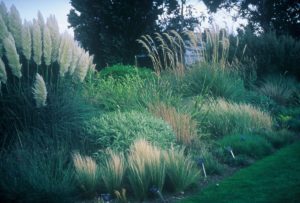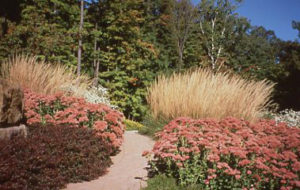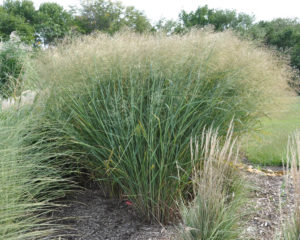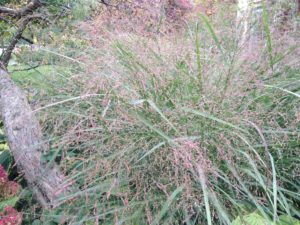
Grass border on windy day at Kew Gardens
To date, I have concentrated on perennials but the ornamental grasses and sedges are also a mainstay of the high performance/low maintenance garden. Most need only be scythed to the ground in very early spring (before the new growth emerges). The range of heights, bloom time, type and color of inflorescence, and foliage color is quite wide so there is sure to be at least one that would fit into your garden.

Drought tolerant linear mass planting of Perovskia and Calamagrostis ‘Karl Foerster’ at World’s Fair Pavilion in St.Louis
Although not a native, Calamagrostis x acutiflora ‘Karl Foerster’ is a grass that maintains its upright foliage and inflorescences during the winter. The linearity of its foliage, approximately two feet high, and inflorescences (another few feet) also provides a textural foil to broader-leaved plants during the growing season. As a cool season grass, it foliates in early April and blooms in early June.
This versatile grass will grow in full sun to bright shade but will lean toward the sun if it is planted in partial shade. It is very tolerant of less than ideal situations such as heavy clay or somewhat dry soil. Although it supposedly grows best in well-drained fertile soil with sufficient moisture, be aware that overwatering tends to make grasses flop. Its sterility eliminates any chance of creating unwanted seedlings.

Calamagrostis acutiflora ‘Karl Foerster’ with Sedum ‘Autumn Joy’ and Berberis ‘Rose Glow’ in October
Unlike many grasses, Calamagrostis x acutiflora ‘Karl Foerster’ does not become as wide as it is tall but stays narrow and tight with a diameter of only eighteen inches. Because this grass foliates so early, it is extremely important to cut it back to the ground by mid-March to avoid damaging the new growth. In the fall, the dark green foliage turns a golden beige and retains that color throughout the winter.

Front yard with Panicum ‘Northwind’ standing erect behind Amsonia hubrichtii
Panicum virgatum (Switch Grass) is a native prairie grass that is particularly useful in our landscapes. It is quite versatile, being effective as a specimen, in masses, as screening, near water, and even in containers. Switch Grass takes its name from the swishing sound it makes when the wind blows. This sturdy grass will remain standing throughout the winter unless buffeted by heavy snows, providing cover and food for birds.

Panicum virgatum ‘Cloud Nine’, one of the tall blue switch grasses, is vase-shaped.
It will grow in full sun or light shade but tends to become floppy in partial shade. While it does best with adequate moisture, as a prairie denizen, it can tolerate periods of drought or flooding. One of the greatest assets of Panicum is its beautiful, relatively upright foliage that curves outward at the tips, giving it a vase-shaped appearance. Typically, the diameter is half of the height.

Panicum ‘Rotstrahlbusch’ inflorescence in September
There are two main groups of Panicum: the blue ones and the red ones. The foliage of blue Panicum is steel-blue and its inflorescences are a pale golden yellow. The foliage of red switch grasses varies from green to garnet-tinged green to almost completely red and its inflorescences are a pale rosy pink. The inflorescences of the red Panicum are pale rosy pink, maturing to pale yellow, and then to beige. Both types have a number of cultivars.
I’ll discuss two other blue grasses next time.


1 Comment